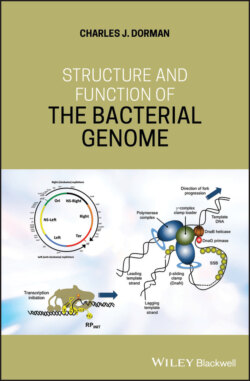Читать книгу Structure and Function of the Bacterial Genome - Charles J. Dorman - Страница 63
1.52 H‐NS Functional Homologues: MvaT from Pseudomonas spp.
ОглавлениеIdentified originally as a transcription regulator of mvaAB, an operon involved in mevalonate metabolism in Pseudomonas mevalonii (Rosenthal and Rodwell 1998), MvaT is now recognised as a NAP with properties analogous to those of H‐NS (Castang and Dove 2010; Tendeng et al. 2003; Winardhi et al. 2012). MvaT binds to AT‐rich DNA in genes that have been acquired by HGT but it uses a binding mechanism that is distinct from other xenogeneic silencers: MvaT prefers binding sites that contain a series of flexible TpA steps and is tolerant of GC interruptions to the target sequence (Ding et al. 2015). MvaT has a paralogue, MvaU, with which it can form heteromeric complexes (Castang et al. 2008). Like MvaT, MvaU can bridge DNA and form filaments along the DNA that exclude other DNA‐binding proteins, enabling it to silence transcription (Winardhi et al. 2014). Mutants deficient in these proteins have altered phenotypes affecting prophage activation, pyocyanin expression biofilm production, and the elaboration of surface fimbriae (Li et al. 2009; Vallet et al. 2004; Vallet‐Gely et al. 2005).
Genes encoding MvaT‐like proteins are found on self‐transmissible plasmids and these proteins influence the transcriptome of the host cell in cooperation with their chromosomally encoded counterparts (Yun et al. 2015). Some bacteria express multiple members of the MvaT family; for example, Pseudomonas putida KT2440 encodes five MvaT orthologues: TurA, TurB, TurC, TurD, and TurE (Renzi et al. 2010). TurC, TurD, and TurE have species‐specific properties while TurA and TurB are similar to MvaT proteins found in all members of the Pseudomonadaceae. TurB is reported not to act generally as a repressor and to affect a smaller group of genes than TurA. These findings illustrate the versatile nature of MvaT‐like proteins and their capacity to acquire new functions through evolution (Renzi et al. 2010).
